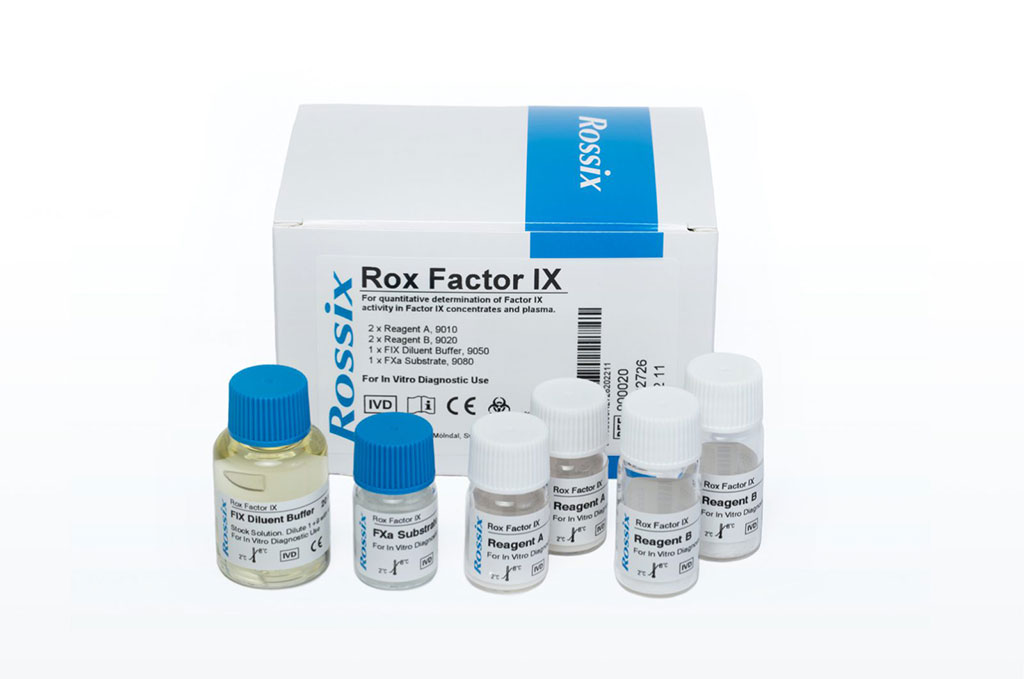Bleeding Phenotype Defined in Nonsevere Hemophiliacs
|
By LabMedica International staff writers Posted on 15 Aug 2022 |

Persons with hemophilia have an increased bleeding tendency in which those with mild hemophilia mainly experience bleeding events provoked by trauma or surgery. In contrast, persons with severe hemophilia, especially when not treated on prophylaxis, experience frequent spontaneous bleeding events.
Hemophilia A and B are inherited bleeding disorders characterized by a deficiency of coagulation factor VIII (FVIII) and factor IX (IX), respectively. Disease severity is based on the residual coagulation FVIII/IX level and is classified as severe (<0.01 IU/mL), moderate (0.01-0.05 IU/mL), or mild ((>0.05-0.40 IU/mL). In persons with nonsevere hemophilia, there is a paucity of detailed information on the bleeding phenotype.
Pediatric Hematologists at the Emma Children’s Hospital (Amsterdam, The Netherlands) and their colleagues included in a multicenter cohort study, males with nonsevere hemophilia A and B (baseline FVIII/IX level, 0.02-0.35 IU/mL) aged 12 to 55 years. In total, 304 persons (70 with moderate hemophilia and 234 with mild hemophilia) were included. The median age was 38 years (interquartile range [IQR], 25-49 years), and the median baseline FVIII/IX level was 0.12 IU/mL (IQR, 0.05-0.21 IU/mL).
Information on age at first treated (joint) bleed, annual bleeding rates (ABRs), and annual joint bleeding rates (AJBRs) was collected from the medical files. The association between baseline FVIII/IX levels and the joint bleeding rate was assessed by using a frailty model for recurrent events. FVIII/IX activity levels were measured by using one-stage clotting assays with corresponding FVIII/IX Actin FS reagent using a Sysmex CS-2500 (Siemens Healthineers, Erlangen, Germany), and the FVIII/IX chromogenic assays were measured with reagents from Siemens and Rossix (Mölndal, Sweden), respectively.
The scientists reported that in total, 245 (81%) persons had experienced at least one bleed, and 156 (51%) had experienced at least one joint bleed. The median age at first bleed and first joint bleed was eight and 10 years, respectively. The median treated annual bleeding rates (ABR) and treated joint bleeds (AJBR) was 0.2 (IQR, 0.1-0.5) and 0.0 (IQR, 0.0-0.2). From baseline FVIII/IX levels 0.02 to 0.05 IU/mL to >0.25 IU/mL, the median ABR decreased from 0.6 (IQR, 0.2-1.4) to 0.1 (IQR, 0.0-0.2) and the AJBR from 0.2 (IQR, 0.0-0.4) to 0.0 (IQR, 0.0-0.0). Baseline FVIII/IX was inversely associated with the joint bleeding rate. Low bleeding rates were observed in persons with nonsevere hemophilia. However, one-half of all adolescents and adults had experienced a joint bleed.
The authors concluded that their study showed that despite low bleeding frequencies, more than one-half of the persons with nonsevere hemophilia had experienced a joint bleed since birth. The joint bleeding rate was inversely associated with the baseline FVIII/IX level. The study was published on July 21, 2022 on the journal Blood Advances.
Related Links:
Emma Children’s Hospital
Siemens Healthineers
Rossix
Latest Hematology News
- MRD Tests Could Predict Survival in Leukemia Patients
- Platelet Activity Blood Test in Middle Age Could Identify Early Alzheimer’s Risk
- Microvesicles Measurement Could Detect Vascular Injury in Sickle Cell Disease Patients
- ADLM’s New Coagulation Testing Guidance to Improve Care for Patients on Blood Thinners
- Viscoelastic Testing Could Improve Treatment of Maternal Hemorrhage
- Pioneering Model Measures Radiation Exposure in Blood for Precise Cancer Treatments
- Platelets Could Improve Early and Minimally Invasive Detection of Cancer
- Portable and Disposable Device Obtains Platelet-Rich Plasma Without Complex Equipment
- Disposable Cartridge-Based Test Delivers Rapid and Accurate CBC Results
- First Point-of-Care Heparin Monitoring Test Provides Results in Under 15 Minutes

- New Scoring System Predicts Risk of Developing Cancer from Common Blood Disorder
- Non-Invasive Prenatal Test for Fetal RhD Status Demonstrates 100% Accuracy
- WBC Count Could Predict Severity of COVID-19 Symptoms
- New Platelet Counting Technology to Help Labs Prevent Diagnosis Errors
- Streamlined Approach to Testing for Heparin-Induced Thrombocytopenia Improves Diagnostic Accuracy
- POC Hemostasis System Could Help Prevent Maternal Deaths
Channels
Clinical Chemistry
view channel
Blood Test Could Predict and Identify Early Relapses in Myeloma Patients
Multiple myeloma is an incurable cancer of the bone marrow, and while many patients now live for more than a decade after diagnosis, a significant proportion relapse much earlier with poor outcomes.... Read more
Compact Raman Imaging System Detects Subtle Tumor Signals
Accurate cancer diagnosis often depends on labor-intensive tissue staining and expert pathological review, which can delay results and limit access to rapid screening. These conventional methods also make... Read moreMolecular Diagnostics
view channel
Multiplex Antibody Assay Could Transform Hepatitis B Immunity Testing
Hepatitis B remains a major global health challenge, yet immunity testing has historically been constrained by cost, operational complexity, and single-analyte approaches. Now, a multiplex antibody assay... Read more
Genetic Testing Improves Comprehensive Risk-Based Screening for Breast Cancer
Breast cancer screening has long relied on age-based guidelines, assuming similar risk across all women despite clear evidence that individual risk varies widely. This one-size-fits-all approach can lead... Read more
Urine Test Could Reveal Real Age and Life Span
Chronological age does not always reflect how quickly the body is aging, as biological age is shaped by genetics, stress, sleep, nutrition, and lifestyle factors such as smoking. A higher biological age... Read more
Genomic Test Identifies African Americans at Risk for Early Prostate Cancer Recurrence
Prostate cancer is one of the most commonly diagnosed cancers in men and a leading cause of cancer-related death, particularly in the United States. African American men face a disproportionately higher... Read moreImmunology
view channel
Ultrasensitive Liquid Biopsy Demonstrates Efficacy in Predicting Immunotherapy Response
Immunotherapy has transformed cancer treatment, but only a small proportion of patients experience lasting benefit, with response rates often remaining between 10% and 20%. Clinicians currently lack reliable... Read more
Blood Test Could Identify Colon Cancer Patients to Benefit from NSAIDs
Colon cancer remains a major cause of cancer-related illness, with many patients facing relapse even after surgery and chemotherapy. Up to 40% of people with stage III disease experience recurrence, highlighting... Read moreMicrobiology
view channel
New UTI Diagnosis Method Delivers Antibiotic Resistance Results 24 Hours Earlier
Urinary tract infections affect around 152 million people every year, making them one of the most common bacterial infections worldwide. In routine medical practice, diagnosis often relies on rapid urine... Read more
Breakthroughs in Microbial Analysis to Enhance Disease Prediction
Microorganisms shape human health, ecosystems, and the planet’s climate, yet identifying them and understanding how they are related remains a major scientific challenge. Even with modern DNA sequencing,... Read morePathology
view channel
Genetics and AI Improve Diagnosis of Aortic Stenosis
Aortic stenosis is a progressive narrowing of the aortic valve that restricts blood flow from the heart and can be fatal if left untreated. There are currently no medical therapies that can prevent or... Read more
AI Tool Simultaneously Identifies Genetic Mutations and Disease Type
Interpreting genetic test results remains a major challenge in modern medicine, particularly for rare and complex diseases. While existing tools can indicate whether a genetic mutation is harmful, they... Read more
Rapid Low-Cost Tests Can Prevent Child Deaths from Contaminated Medicinal Syrups
Medicinal syrups contaminated with toxic chemicals have caused the deaths of hundreds of children worldwide, exposing a critical gap in how these products are tested before reaching patients.... Read more
Tumor Signals in Saliva and Blood Enable Non-Invasive Monitoring of Head and Neck Cancer
Head and neck cancers are among the most aggressive malignancies worldwide, with nearly 900,000 new cases diagnosed each year. Monitoring these cancers for recurrence or relapse typically relies on tissue... Read moreTechnology
view channel
Pioneering Blood Test Detects Lung Cancer Using Infrared Imaging
Detecting cancer early and tracking how it responds to treatment remains a major challenge, particularly when cancer cells are present in extremely low numbers in the bloodstream. Circulating tumor cells... Read more
AI Predicts Colorectal Cancer Survival Using Clinical and Molecular Features
Colorectal cancer is one of the most common and deadly cancers worldwide, and accurately predicting patient survival remains a major clinical challenge. Traditional prognostic tools often rely on either... Read moreIndustry
view channel
BD and Penn Institute Collaborate to Advance Immunotherapy through Flow Cytometry
BD (Becton, Dickinson and Company, Franklin Lakes, NJ, USA) has entered into a strategic collaboration with the Institute for Immunology and Immune Health (I3H, Philadelphia, PA, USA) at the University... Read more



















